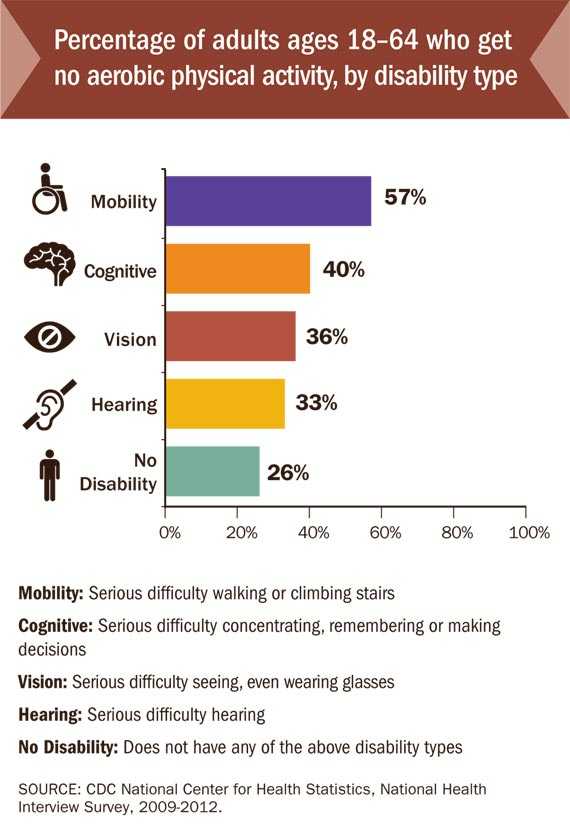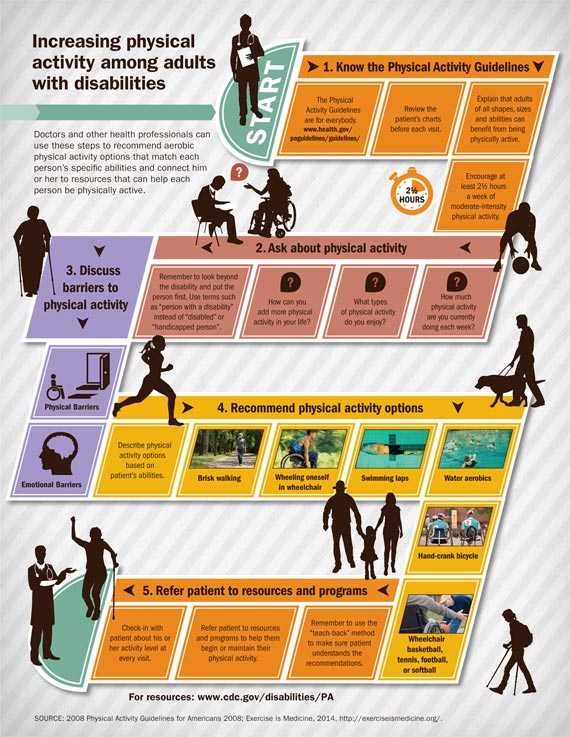Adults with Disabilities
Physical activity is for everybody
May 2014


 3x
3x
Adults with disabilities are 3 times more likely to have heart disease, stroke, diabetes, or cancer than adults without disabilities.
 1 in 2
1 in 2
Nearly half of all adults with disabilities get no aerobic physical activity, an important health behavior to help avoid these chronic diseases.
 82%
82%
Adults with disabilities were 82% more likely to be physically active if their doctor recommended it.
More than 21 million US adults 18–64 years of age have a disability. These are adults with serious difficulty walking or climbing stairs; hearing; seeing; or concentrating, remembering, or making decisions. Most adults with disabilities are able to participate in physical activity, yet nearly half of them get no aerobic physical activity. Physical activity benefits all adults, whether or not they have a disability, by reducing their risk of serious chronic diseases, such as heart disease, stroke, diabetes and some cancers. Only 44% of adults with disabilities who visited a doctor in the past year were told by a doctor to get physical activity. Yet adults with disabilities were 82% more likely to be physically active if their doctor recommended it.
Doctors and other health professionals can:
- Ask adults with disabilities how much physical activity they get each week.
- Remind adults with disabilities to get regular physical activity consistent with their abilities. They should try to get at least 2 1/2 hours a week of moderate-intensity physical activity. If this is not possible, some activity is better than none.
- Recommend physical activity options that match the specific abilities of each person and connect them to resources that can help each person be physically active.
Problem
More adults with disabilities need to get physical activity.
Adults with disabilities who get no physical activity are 50% more likely to have certain chronic diseases than those who get the recommended amount of physical activity.
- Aerobic physical activity can help all adults avoid costly and deadly chronic diseases such as heart disease, stroke, diabetes, and some cancers.
- 1 in 2 adults with disabilities get no aerobic physical activity compared with 1 in 4 adults without disabilities.
- Adults with mobility limitations (serious difficulty walking or climbing stairs) are the least likely to get any aerobic physical activity. Nearly 6 in 10 of them do not get any aerobic physical activity.
- Adults with disabilities face physical and emotional barriers to getting aerobic physical activity, including:
- Knowing about and getting to programs, places, and spaces where they can be physically active;
- Having social support for physical activity;
- Finding fitness and health professionals who can provide physical activity options that match their specific abilities.

Adults with disabilities are more likely to get physical activity if doctors recommend it.
- Only 44% of adults with disabilities who visited a doctor in the past year got a physical activity recommendation from their doctor.
- Adults with disabilities who got a physical activity recommendation from their doctor were 82% more likely to be physically active than those who did not get one.
- It is critical for doctors to know the Physical Activity Guidelines and help their patients with disabilities overcome barriers to reach their physical activity goals.

Infographic
What Can Be Done
Federal government is
- Funding national and state programs to develop physical activity programs for adults with disabilities.
- Measuring state and national progress towards getting all US adults physically active through the Disability and Health Data System (DHDS) and other systems.
- Providing accessible and high-quality health care to adults with disabilities by improving training and cultural competency for doctors and other health professionals.
Doctors and other health professionals can
- Ask adults with disabilities about how much physical activity they get each week.
- Remind adults with disabilities to get regular physical activity. They should try to get at least 2 hours and 30 minutes a week of moderate-intensity physical activity. If this is not possible, patients with disabilities should avoid inactivity; some activity is better than none.
- Recommend physical activity options that match each person's specific abilities and connect him or her to resources that can help each person be physically active.
- Use CDC's website to find resources that can help you talk to patients with disabilities about physical activity.
States and communities can
- Bring together adults with disabilities, health professionals, and community leaders to address resource needs to increase physical activity.
- Make sure physical activity, recreation, and sport-based program opportunities are accessible to adults with disabilities.
- Incorporate community features such as proper curb cuts on sidewalks, ramps for wheelchair access, and well-maintained trails to improve safe access to public places for physical activity.
- Encourage fitness and recreation facilities to have low-counter front desks for wheelchair users, family changing areas in locker rooms, push-button operated doors, and elevators.
Adults with disabilities can
- Talk to your doctor about how much and what kind of physical activity is right for you.
- Find opportunities to increase physical activity regularly in ways that meet your needs and abilities.
- Regular aerobic physical activity increases heart and lung function; improves daily living activities and independence; decreases chances of developing chronic diseases; and improves mental health.
- Start slowly based on your abilities and fitness level (e.g. be active for at least 10 minutes at a time, slowly increase activity over several weeks, if necessary).
Science Behind the Issue
Related Pages
- Vital Signs Issue Details: Disability and Physical Activity-United States, 2009-2012 (MMWR)
- Vital Signs Press Release
- Vital Signs Digital Press Kit
- Disability and Physical Activity: Resources for Doctors and other Health Professionals
- Vital Signs – Adults with Disabilities [PODCAST – 1:15 minutes]
- Vital Signs – Adults with Disabilities [PSA – 0:60 seconds]
- What’s Disability to Me? [VIDEO – 4:37 minutes]
- Grand Rounds archive: Where in health is disability? Public health practices to include people with disabilities
- CDC Feature: 10 Things to Know about Physical Activity among Adults with Disabilities
- Mark’s Story [VIDEO – 2:40 minutes]
- Disability and Health website
- Disability and Health Programs
- Disability and Health Data System (DHDS)
- CDC Healthy Weight Issue Briefs
- CDC Physical Activity For Adults
- CDC Arthritis and Physical Activity
On Other Web Sites
- MedlinePlus – Disabilities
- 2008 Physical Activity Guidelines for Americans
- Be Active Your Way: A Guide for Adults [PDF – 1.09 MB]
- The Doctor’s Channel – Tom Frieden, MD, MPH on How Doctors Can Help Patients with Disabilities Become More Physically Active
- MedPage Today – Dianna Carroll, PhD, MS, discussing disability and physical activity
- Page last reviewed: May 6, 2014
- Page last updated: May 6, 2014
- Content source:
- National Center on Birth Defects and Developmental Disabilities, Division of Human Development and Disability
- Page maintained by: Office of the Associate Director for Communications (OADC)


 ShareCompartir
ShareCompartir
